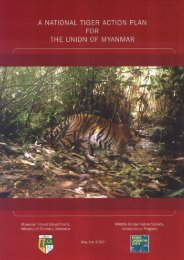Download - Global Tiger Initiative
Download - Global Tiger Initiative
Download - Global Tiger Initiative
You also want an ePaper? Increase the reach of your titles
YUMPU automatically turns print PDFs into web optimized ePapers that Google loves.
north-west Himalayan tourist towns of Srinagar and Manali (Osborne et al., 1983). No Snow<br />
Leopard bones have yet been positively identified in trade in India (M. Misra, TRAFFIC<br />
consultant, in litt., 2002). No comprehensive market surveys for Snow Leopard products have<br />
been undertaken recently in India, but TRAFFIC India compiled information on incidences of<br />
poaching and trade involving Snow Leopards over several years (see Table 4). Further<br />
indication of trade in Snow Leopard products is available as a result of an inventory of fur items<br />
with furriers in Jammu and Kashmir, conducted by State authorities, in 1997. This inventory<br />
was initiated with the aim of compensating furriers before all furs of protected species were<br />
confiscated and the fur trade closed (M. Misra, TRAFFIC consultant, in litt., 2002). Table 5<br />
shows the number of Snow Leopard skin items reported to the authorities. Although this is not<br />
the total number of Snow Leopard products stocked by furriers (as not all reported their stocks),<br />
a considerable number of Snow Leopard skins and garments were held. Following the<br />
inventory, the compensation scheme ran into difficulties and, instead of being destroyed, the<br />
skins and garments remained with the furriers (M. Misra, TRAFFIC consultant, in litt., 2002).<br />
Table 5<br />
Findings of an inventory of furriers in Jammu and Kashmir in 1997.<br />
Fur item Quantity Price per item (INR)<br />
Snow Leopard skin 98 10 000 (USD200)<br />
Snow Leopard coat (long) 11 50 000 (USD1030)<br />
Snow Leopard coat (short) 5 30 000 (USD620<br />
Mounted Snow Leopard skin 6 11 000 (USD230)<br />
Snow Leopard head 1 100 (USD20)<br />
Snow Leopard hats and gloves 8 200 (USD4)<br />
Source: Anon., 1997.<br />
Mongolia<br />
Conflict with herders<br />
Snow Leopard predation of livestock is causing significant problems in most areas of the<br />
species’s range in Mongolia. Consequently, killings of Snow Leopards by herders, to prevent<br />
such attacks, are considered one of the greatest threats posed to the species in Mongolia<br />
(Munkhtsog, 2002). It is assumed that most Snow Leopard skins offered for sale in markets<br />
local to herders, or in Ulaanbaatar, are from Snow Leopards killed by herders wanting to protect<br />
their stock. Snow Leopard killings of livestock can constitute a significant economic loss to<br />
local herders, who often are entirely dependent on their herds for subsistence and additional<br />
cash income, for example from the sale of wool. In recent years many herder families have<br />
suffered dramatic losses in livestock (up to 80% in some areas) after exceptionally harsh winters<br />
in 2002 and 2003 (B. Munkhtsog, in litt., 2003; Anon., 2000c). At the same time, the market<br />
value for cashmere wool dropped from an average of USD40/kg, in 2001, to USD10 to 15/kg,<br />
in 2003 (Munkhtsog, 2002), exacerbating the effect of any predation on domestic stock by Snow<br />
Leopards. Authorities in Mongolia recorded the case, in 2000, of a Snow Leopard killed by a<br />
herder in retribution for the taking of five sheep and two young cows, in the Bayanzurkh<br />
FADING FOOTPRINTS: the killing and trade of Snow Leopards 31

















